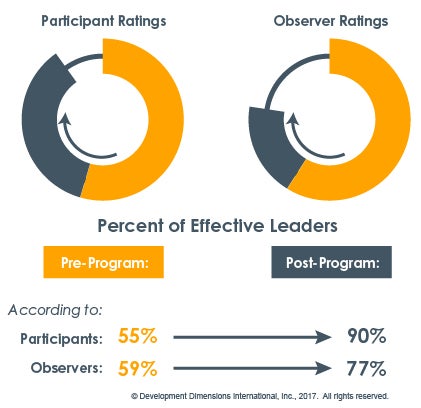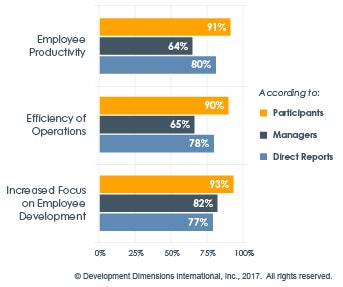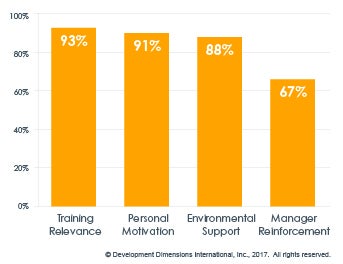The Need
Give frontline leaders the skills needed to grow the business.
The Solution
A comprehensive leadership development program.
The Result
Increased overall leadership quality and a greater number of capable leaders within the organization.
Business Need
FactSet, a U.S.-based multinational financial data and software company, provides financial information and analytic software for investment professionals. Nearly four decades of financial success (FactSet has experienced revenue growth for 37 consecutive years) coupled with a commitment to employee and leader engagement and growth have helped the 8,800-employee organization earn repeated recognition on Fortune’s “100 Best Companies to Work For” list.
A key ingredient to FactSet’s success is its commitment to developing leadership capabilities through initiatives such as its leadership development program, a set of training workshops catering to frontline leaders. FactSet Manila—the company’s second-largest office in the world—partnered with DDI to evaluate the impact of this initiative. This report summarizes the results for participants in 2015 through 2016.
The leadership development program consisted of five half-day courses from DDI’s Interaction Management® system delivered across six to eight months. The program was aimed at foundational leadership skills like communication, delegation, and motivating others. Classroom learning was supported by a variety of post-learning tools including simulations, mobile refreshers, and manager support.
Solution
FactSet partnered with DDI to implement a leadership development program to equip leaders with skills to grow the business and its people by:
- Strengthening systems.
- Building and sustaining relationships.
- Empowering teams.
- Adapting to changes.
Results
Based on an impact study of program participants in 2015 and 2016:
- More than 90 percent of team leads who attended the training are applying what they learned.
- Higher levels of employee engagement, job satisfaction, team productivity, and collaboration have been observed.
- FactSet has increased overall quality and the number of capable leaders within the organization.
Research Design
DDI’s impact evaluation survey looked at the use and impact of FactSet’s ongoing leadership development program on participants, their teams, and the business. This online survey focused on the program’s behavioral objectives and specific goals. Participants and their observers (their managers, colleagues, and direct reports) received the survey several months after the participants had completed the program, allowing the participants enough time to apply what they had learned. Participants and their observers were asked to rate the extent to which the participants engaged in desired behaviors before and after completing the program. The survey also gathered viewpoints on how the program impacted other organizational outcomes and identified opportunities to increase the program’s impact.
Surveys were sent to 85 leaders who participated in the leadership development program during 2015 and 2016. Of that number, 67 completed the survey, resulting in a 79 percent response rate. Surveys were also sent to observers who were in a position to rate participants’ behavior both before and after they attended the sessions. In all, 602 observers responded: 415 direct reports, 55 managers, and 132 participant colleagues.
Impact
Behavior Change
Seven behaviors were identified as learning and application objectives. Participants and observers alike were asked to rate the frequency (“never,” “rarely,” “sometimes,” “often,” or “almost always”) with which participants exhibited each behavior both before and after attending the program. The survey analysis focused on the percentage of trainees who displayed each behavior “often” or “almost always,” thus consistently showing themselves to be effective leaders. The impact of the training program can be seen in the percentage of effective leaders before versus after attending the program.
Based on the behavioral objectives, Figure 1 shows that 90 percent of participants reported engaging in effective leadership behaviors as a result of attending the program—a 35 percent overall improvement from before the program. Observers indicated that 77 percent of participants were engaging in effective behaviors after attending the program—an 18 percent improvement. Overall, participants are applying what they learned in the leadership development program back in the workplace.

According to program participants and their observers, participants made the greatest improvements in behaviors taught in Communicating for Leadership Success. A 40 percent improvement was reported by participants to go along with a 20 percent improvement noted by observers. This was followed closely by a 39 percent improvement in behaviors taught in Develop and Retain Talent, 38 percent in Build Engagement and Trust, and 37 percent in Coaching for Performance, as reported by participants.
Impact on Talent
The impact evaluation survey assessed not only improvements in participants’ skills, but also in the productivity of colleagues (direct reports and peers). Observers rated the overall increase in their own efficiency that they would attribute to participants’ improved leadership skills. They used a scale of 0 to 100 percent (0 = no improvement or improvement not due to better leadership; 100 = observers’ efficiency doubled as a direct result of improvements in participants’ leadership abilities). On average, observers reported a 66 percent overall improvement in their own efficiency attributed to the leadership development program.
Both participants and observers also were asked to use a similar scale (0 to 100 percent) to rate overall improvement in three different team-level outcomes. Figure 2 shows average ratings for each of the team-level outcomes that can be attributed directly to the program as rated by participants, their managers, and their direct reports.

Program Support and Sustainability
To ensure the program’s success and long-term sustainability, the survey also asked participants to rate the program according to four support factors. While two out of every three participants surveyed said they have discussed specific application opportunities with their manager and have created a development plan to outline next steps, manager reinforcement can be improved further because of the potential impact. Manager support has the greatest impact in ensuring that knowledge and skills from a program translate back to behavior in the workplace.
In terms of training relevance (Figure 3), 93 percent of participants felt the program addressed skills and concepts important for their job and provided them with ample opportunities to practice. Ninety-one percent felt highly motivated to learn the new concepts and skills because of the program’s alignment with their own personal goals and career growth. Eighty-eight percent of leaders felt they had opportunities to apply the skills back in the workplace and that their peers were open to new ways of working.

Impact on the Business
Clearly, improved employee productivity and efficiency have a direct—and major—impact on the business, as do the substantial improvements participants and observers noted in leader and direct report engagement, morale, and communication. For example, 71 percent of direct reports noted that over the past year their manager has boosted their commitment to the organization. Additionally, 80 percent of direct reports indicated that their manager has made them feel more valued, and 83 percent reported that their manager has increased their level of engagement. These types of results reduce turnover and the costs associated with recruiting, hiring, and training employees.
Just as important, leadership bench strength—the readiness of leaders to move into key positions as the need arises—has increased. More than 90 percent of participants and their managers agreed that the leadership development program has increased overall quality of frontline leaders at FactSet. Moreover, nearly 70 percent of participants’ managers indicated that participants’ viability for promotion has increased as a result of attending the leadership development program.
Overall, the results of this study clearly indicate that FactSet’s leadership development program has had a positive impact on participants, as well as on the attitudes and performance of participants’ work groups.
Learn how DDI can help you transform your leaders to transform your business.
Topics covered in this blog


